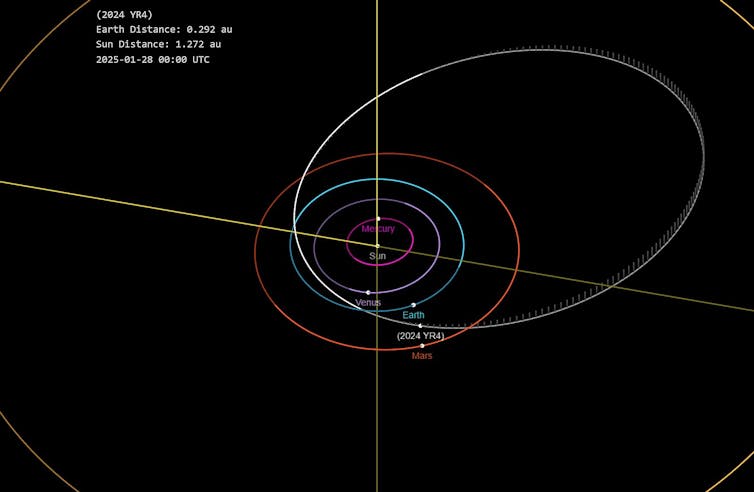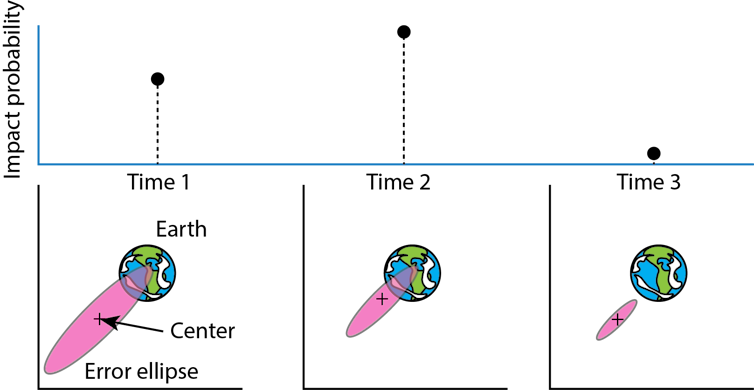I was preparing for my early morning class back in January 2025 when I received a notice regarding an asteroid called 2024 YR4. It said the probability it could hit Earth was unusually high.
As defending Earth from unexpected intruders such as asteroids is part of my expertise, I immediately started receiving questions from my students and colleagues about what was happening.
When scientists spot an asteroid whose trajectory might take it close to Earth, they monitor it frequently and calculate the probability that it might collide with our planet. As they receive more observational data, they get a better picture of what could happen.
Just having more data points early doesn’t make scientists’ predictions better. They need to keep following the asteroid as it moves through space to better understand its trajectory.
Reflecting on the incident a few months later, I wondered whether there might have been a better way for scientists to communicate about the risk with the public. We got accurate information, but as the questions I heard indicated, it wasn’t always enough to understand what it actually means.
Numbers Change Every Day
The 2024 YR24 asteroid has a diameter of about 196 feet (60 meters) – equivalent to approximately a 15-story building in length.
At the time of the announcement in January, the asteroid’s impact probability was reported to exceed 1%. The impact probability describes how likely a hazardous asteroid is to hit Earth. For example, if the impact probability is 1%, it means that in 1 of 100 cases, it hits Earth. One in 100 is kind of rare, but still too close for comfort if you’re talking about the odds of a collision that could devastate Earth.
Over time, though, further observations and analyses revealed an almost-zero chance of this asteroid colliding with Earth.
After the initial notice in January, the impact probability continuously increased up to 3.1% on Feb. 18, but dropped to 1.5% on Feb. 19. Then, the impact probability continuously went down, until it hit 0.004% on Feb. 24. As of June 15, it now has an impact probability of less than 0.0000081%.
But while the probability of hitting Earth went down, the probability of the asteroid hitting the Moon started increasing. It went up to 1.7% on Feb. 24. As of April 2, it is 3.8%.
If it hits the Moon, some ejected materials from this collision could reach the Earth. However, these materials would burn away when they enter the Earth’s thick atmosphere.
Impact Probability
To see whether an approaching object could hit Earth, researchers find out what an asteroid’s orbit looks like using a technique called astrometry. This technique can accurately determine an object’s orbit, down to only a few kilometers of uncertainty. But astrometry needs accurate observational data taken for a long time.
Any uncertainty in the calculation of the object’s orbit causes variations in the predicted solution. Instead of one precise orbit, the calculation usually gives scientists a cloud of its possible orbits. The ellipse enclosing these locations is called an error ellipse.
The impact probability describes how many orbital predictions in this ellipse hit the Earth.
Without enough observational data, the orbital uncertainty is high, so the ellipse tends to be large. In a large ellipse, there’s a higher chance that the ellipse “accidentally” includes Earth – even if the center is off the planet. So, even if an asteroid ultimately won’t hit Earth, its error ellipse might still include the planet before scientists collect enough data to narrow down the uncertainty.
As the level of uncertainty goes down, the ellipse shrinks. So, when Earth is inside a small error ellipse, the impact probability may become higher than when it’s inside a large error ellipse. Once the error ellipse shrinks enough that it no longer includes Earth, the impact probability goes down significantly. That’s what happened to 2024 YR4.
The impact probability is a single, practical value offering meaningful insight into an impact threat. However, just using the impact probability without any context may not provide meaningful guidelines to the public, as we saw with 2024 YR4.
Holding on and waiting for more data to refine a collision prediction, or introducing new metrics for assessing impacts on Earth, are alternative courses of action to provide people with better guidelines for future threats before adding confusion and fear.![]()
This article is republished from The Conversation under a Creative Commons license. Read the original article.














![<p>Sun Geun Yoon works in a glove box in McDowell’s laboratory at Georgia Tech. [Photo by Christopher McKenney]</p> Sun Geun Yoon works in a glove box in McDowell’s laboratory at Georgia Tech.](/sites/default/files/styles/wide/public/news/2025-07/Solid-State-Battery_052925-5.jpg.webp?itok=Wc8hWmXY)